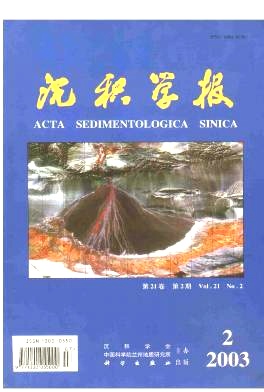CAO Ying-chang, JIANG Zai-xing, XIA Bin, YANG Wei-li, ZHANG Jia-zhen. Method, Principle and Example of Identifying Sequence Stratigraphical Boundary Using Sonic Logging[J]. Acta Sedimentologica Sinica, 2003, 21(2): 318-323.
| Citation:
|
CAO Ying-chang, JIANG Zai-xing, XIA Bin, YANG Wei-li, ZHANG Jia-zhen. Method, Principle and Example of Identifying Sequence Stratigraphical Boundary Using Sonic Logging[J]. Acta Sedimentologica Sinica, 2003, 21(2): 318-323.
|
Method, Principle and Example of Identifying Sequence Stratigraphical Boundary Using Sonic Logging
- 1.
Guangzhou Institute of Geochemistry, Chinese Academy of Sciences, Guangzhou 510640;
- 2.
Faculty of Geo-Resource and Information, University of Petroleum, Dongying, Shandong 257061;
- 3.
Shengli Oil Field Limited Company, Dongying,Shandong 257015
- Received Date: 2001-11-14
- Rev Recd Date:
2002-03-13
- Publish Date:
2003-06-10
-
Abstract
On the base of the comprehensive analysis of seismic data, core and logging , we have discussed the method and principle of identifying sequence stratigraphical boundary with sonic logging, and its application in the study of sequence stratigraphy of Paleogene in Jiyang depression. The sequence boundary and the maximal lacustrine flooding surface (MLFS) are the key boundaries in the sequence strata. The sequence boundary corresponds to the unconformity surface or its corresponding conformity surface, and MLFS is the division surface between transgressive systems tract (TST) and high systems tract (HST), and condensed section (CS) can form near the MLFS. The regression line of the logarithm of interval transit-time of mud rocks versus its depth is a straight line in the basin under the normal imbedding and compacting conditions, but the unconformity usually leads to the formation of stratigraphical break, weathered crust and TST mud, and these characteristics also lead to the anomaly of the regression line, such as, the dislocation and different slope of the regression line above or below the unconformity surface and some anomaly of interval transit time below the unconformity surface, and they are the important identifying signs of sequence boundaries. The lithology of the CS is usually depth-water shale or mudstone, and it has high content of the organic substance and high interval transit time. The interval transit time is the highest at the location of the maximal lacustrine flooding surface, and becomes lower upward and downward in a sequence, and reach the lowest value at the location of the sequence boundary
-
References
|
[1]
|
姜在兴,李华启,王留奇等编.层序地层学原理及应用[M].北京:石油工业出版社,1996[Jiang Zaixing,Li Huaqi et al.Principles and applications of sequence stratigraphy[M]. Beijing: Petroleun Industry Publishing House, 1996 ] |
|
[2]
|
付广,张发强.利用声波时差资料研究欠压实泥岩盖层古压力封闭能力的方法[J].石油地球物理勘探,1998,33(6):812~818[Fu Guang, Zhang Faqiang. A method of analyzing the palaeo-pressure sealing ability of poorly compacted shale barrier with the use of acoustic logging data. OGP, 1998, 33(6):812~818 ] |
|
[3]
|
张小莉,程玉群.地层压力分析的有效途径[J].西安石油学院学报,1999,14(6):28~30[ZhangXiaoli,Cheng Yuqun.An effective way to analyze formation pressure[J]. Journal of Xian Petroleum Institute, 1999,14(6): 28~30] |
|
[4]
|
张小莉,沈英,陈文学.利用测井资料分析成岩作用对储集层的影响[J].沉积学报,2000,18(1):127~131[Zhang Xiaoli,Shen Ying,Chen Wenxue. Application of well logging information to analysis on the effect of diagenesis in reservoirs[J]. Acta Sedimentologica Sinica,2000,18(1) :127~131 ] |
|
[5]
|
Wyllie M R J, Gregory A R, Gardner L W. Elastic wave velocities in heterogeneous and porous media[J]. Geophysics, 1956, 21:41~70 |
|
[6]
|
丁次乾主编.矿场地球物理[M].山东东营:石油大学出版社,1992[Ding Ciqian.Exploring geophysics[M].Dongying Shandong:Petroleum University Publishing House,1992] |
|
[7]
|
周瑶琪,吴智平.地层间断面的时间结构研究[M].北京:地质出版社,2000[ZhouYaoqi,WuZhiping.Study on the time composition of the hiatus surface[M]. Beijing: Geological Publishing House, 2000] |
|
[8]
|
Passey Q R. A practical model for organic richness from porosity and resistivity logs[J]. AAPG Bulletin, 1990, 74(12): 1 777~1 794 |
|
[9]
|
张志伟,张龙海.测井评价烃源岩的方法及其应用效果[J].石油勘探与开发,2000,27(3):84~87[Zhang Zhiwei,Zhang Longhai.A method of source rock evaluation by well-logging and its application result[J]. Petroleum Exploration and Development, 2000,27 (3): 84 ~87] |
-
-
Proportional views

-






 DownLoad:
DownLoad: